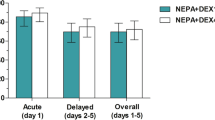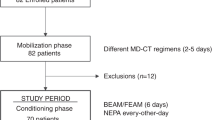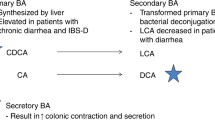Abstract
This prospective study describes chemotherapy-induced nausea and vomiting (CINV) in children (4–18 years) receiving their first hematopoietic stem cell transplant. Emetic episodes, nausea severity (assessed using a validated, self-report nausea severity assessment tool) and antiemetic administration were documented from the start of conditioning until 24 h after the last conditioning agent was administered (acute) and for a further 7 days (delayed). Relationships between CINV control and parenteral nutrition (PN) use and acute gut GvHD (aGvHD) were explored. Fifty-nine children (4.6–17.4 years) were evaluable. Complete chemotherapy-induced vomiting (CIV; acute: 24%; delayed 22%) and chemotherapy-induced nausea (CIN; acute 7%; delayed 12%) control rates were low. Few children experienced complete CINV control (no vomiting/retching and no nausea) during the acute (5%) or delayed phases (12%). Children experiencing complete acute or delayed CIN control or complete delayed CIV control were more likely to have received: a lower proportion of their total energy requirement as PN at the end of the delayed phase (P<0.036) and PN for a shorter time (P<0.044). Low patient numbers did not permit evaluation of the association between gut aGvHD and CINV control. Effective and safe interventions aimed at improving CINV control in children are required.
This is a preview of subscription content, access via your institution
Access options
Subscribe to this journal
Receive 12 print issues and online access
$259.00 per year
only $21.58 per issue
Buy this article
- Purchase on Springer Link
- Instant access to full article PDF
Prices may be subject to local taxes which are calculated during checkout

Similar content being viewed by others
References
Basch E, Prestrud A, Hesketh P, Kris M, Feyer P, Somerfield MR et al. Antiemetics: American Society of Clinical Oncology Clinical Practice Guideline Update. J Clin Oncol 2011; 29: 4189–4198.
Molassiotis A, Stamataki Z, Kontopantelis E . Development and preliminary validation of a risk prediction model for chemotherapy-related nausea and vomiting. Support Care Cancer 2013; 21: 2759–2767.
Papadopoulou A, MacDonald A, Williams M, Darbyshire P, Booth I . Enteral nutrition after bone marrow transplantation. Arch Dis Child 1997; 77: 131–136.
Mattsson J, Westin S, Edlund S, Remberger M . Poor oral nutrition after allogeneic stem cell transplantation correlates significantly with severe graft-versus-host disease. Bone Marrow Transplant 2006; 38: 629–633.
Thorvaldson L, Remberger M, Winiarski J, Omazic B, Fischler B, Sundin M . HLA, GVHD, and parenteral nutrition are risk factors for hepatic complications in pediatric HSCT. Pediatr Transplant 2016; 20: 96–104.
Kuiken N, Rings E, Havinga R, Groen A, Tissing W . Effect of minimal enteral feeding on recovery in a methotrexate-induced gastrointestinal mucositis rat model. Support Care Cancer 2016; 24: 1357–1364.
Kusnierczyk N, Saunders EF, Dupuis LL . Outcomes of antiemetic prophylaxis in children undergoing bone marrow transplantation. Bone Marrow Transplant 2002; 30: 119–124.
Dupuis LL, Taddio A, Kerr EN, Kelly A, MacKeigan L . Development and validation of a pediatric nausea assessment tool (PeNAT) for use by children receiving antineoplastic agents. Pharmacotherapy 2006; 26: 1221–1231.
Dupuis LL, Boodhan S, Sung L, Portwine C, Hain R, McCarthy P et al. Guideline for the classification of the acute emetogenic potential of antineoplastic medication in pediatric cancer patients. Pediatr Blood Cancer 2011; 57: 191–198.
Glucksberg H, Storb R, Fefer A, Buckner CD, Neiman PE, Clift RA et al. Clinical manifestations of graft-versus-host disease in human recipients of marrow from HL-A-matched sibling donors. Transplantation 1974; 18: 295–304.
Przepiorka D, Weisdorf D, Martin P, Klingemann HG, Beatty P, Hows J et al. 1994 Consensus Conference on acute GVHD grading. Bone Marrow Transplant 1995; 15: 825–828.
Orchard P, Rogosheske J, Burns L, Rydholm N, Larson H, DeFor T et al. A prospective randomized trial of the anti-emetic efficacy of ondansetron and granisetron during bone marrow transplantation. Biol Blood Marrow Transplant 1999; 5: 386–393.
Hewitt M, Cornish J, Pamphilon D, Oakhill A . Effective emetic control during conditioning of children for bone marrow transplantation using ondansetron, a 5-HT3 antagonist. Bone Marrow Transplant 1991; 7: 431–433.
Frakes L, Brehm T, Kosty M, Miller W, mcMillan R, Mason J et al. An all oral antiemetic regimen for patients undergoing high-dose chemotherapy with peripheral blood stem cell transplant. Bone Marrow Transplant 1997; 20: 473–478.
Andrews P, Sanger G . Nausea and the quest for the perfect anti-emetic. Eur J Pharmacol 2014; 722: 108–121.
Navari RM, Qin R, Ruddy KJ, Liu H, Powell SF, Bajaj M et al. Olanzapine for the prevention of chemotherapy-induced nausea and vomiting. N Engl J Med 2016; 375: 134–142.
Cruz F, de Iracema Gomes Cubero D, Taranto P, Lerner T, Thaunaturgo Lera A, da Costa Miranda M et al. Gabapentin for the prevention of chemotherapy- induced nausea and vomiting: a pilot study. Support Care Cancer 2012; 20: 601–606.
Rodgers C, Young A, Hockenberry M, Binder B, Symes L . The meaning of adolescents' eating experiences during bone marrow transplant recovery. J Pediatr Oncol Nurs 2010; 27: 65–72.
Acknowledgements
The generosity of the children and families who participated in this study is sincerely appreciated. The support and contributions of the nursing, medical and pharmacy staff of the Bone Marrow Transplantation Unit at The Hospital for Sick Children, and the assistance of Ms Mila Khanna and Ms Ashlee Vennettilli, Clinical Research Project Coordinators, Research Institute, The Hospital for Sick Children are gratefully acknowledged.
Author information
Authors and Affiliations
Corresponding author
Ethics declarations
Competing interests
The authors declare no conflict of interest.
Rights and permissions
About this article
Cite this article
Flank, J., Sparavalo, J., Vol, H. et al. The burden of chemotherapy-induced nausea and vomiting in children receiving hematopoietic stem cell transplantation conditioning: a prospective study. Bone Marrow Transplant 52, 1294–1299 (2017). https://doi.org/10.1038/bmt.2017.112
Received:
Revised:
Accepted:
Published:
Issue Date:
DOI: https://doi.org/10.1038/bmt.2017.112
This article is cited by
-
Evaluation of chemotherapy-induced nausea and vomiting in pediatric patients with high-grade glioma treated with lomustine—a case series
Supportive Care in Cancer (2024)
-
Pain, Fatigue, Nausea, and Vomiting as the Predictors of Anxiety in Patients Undergoing Hematopoietic Stem Cell Transplantation: A Prospective Cohort Study
Supportive Care in Cancer (2022)
-
Interventions for the prevention of acute phase chemotherapy-induced nausea and vomiting in adult and pediatric patients: a systematic review and meta-analysis
Supportive Care in Cancer (2022)
-
Antiemetic prophylaxis with fosaprepitant and granisetron in pediatric patients undergoing allogeneic hematopoietic stem cell transplantation
Journal of Cancer Research and Clinical Oncology (2020)
-
Long-term aprepitant for nausea and vomiting associated with gastroparesis in hematopoietic stem cell transplantation
Bone Marrow Transplantation (2018)



